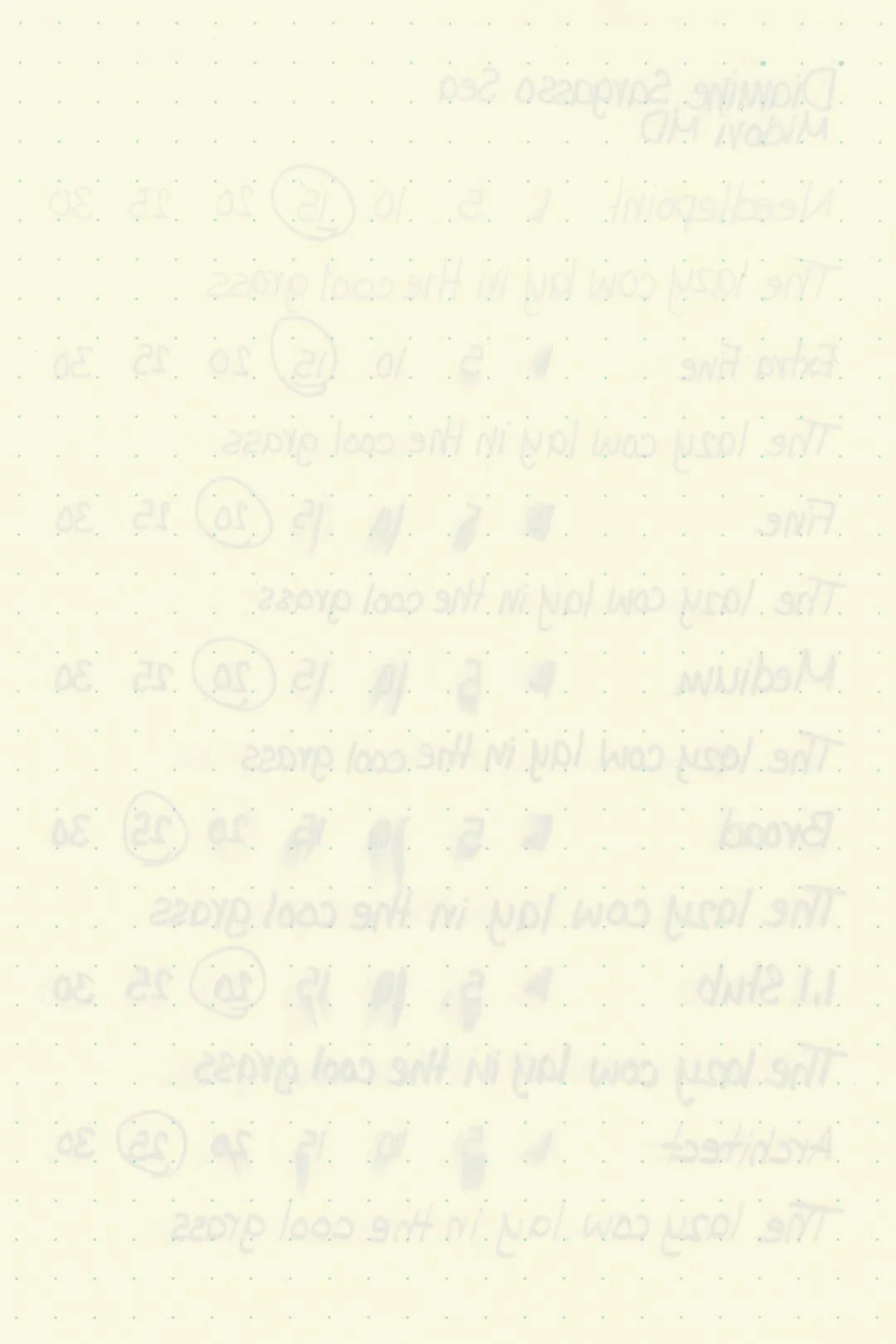Diamine Sargasso Sea
Ink Review #24
*Please note that the scan is the accurate representation of this color.
Overview
The color/properties:
Diamine Sargasso Sea is an especially vibrant medium blue that appears solid, with minimal variations in tone or intensity. I wouldn’t go as far as to call Sargasso Sea a sheening ink, but some papers, such as Tomoe River, Midori MD, bring out a distinct sheen. There’s still a possibility for a slight sheen on other papers, but it’s more muted and not nearly as noticeable.
On papers that this ink doesn’t sheen on, it comes through surprisingly bright. I think this would be an excellent choice for a solid, non-shading blue, but I would like to note that this ink has a very potent odor to it. It’s not unlike what I’ve smelled from several other Diamine inks — it’s definitely normal — but I didn’t find it pleasant.
Ink splat
Ink droplets
Rhodia
Leuchtturm1917
Performance on paper:
Sargasso Sea generally performed well on paper. There was only a typical, but minor amount of bleeding on the Kokuyo paper, but otherwise, there was no detectible bleeding or feathering on the other five test sheets.
The dry times were slightly below average. The larger nibs often took longer than 20 seconds to dry, and in some cases extended past the 30-second mark. Keep in mind though that this is a highly saturated blue and it will most likely smudge no matter how long it’s been dry with even the slightest amount of residual moisture on the hand.
There was some water resistance. The water creates a blue cloud, but I found the results to be readable.
Midori MD
Maruman
Tomoe River
Kokuyo
Water resistance
Chromatography
Performance in the pen:
Diamine Sargasso Sea has a medium-wet flow that felt consistent across all the test nibs. Despite the flow, I felt that the lubrication would have been better. It wasn’t necessarily unpleasant, and it made for a usable, average writing experience, but I expected more. Still, during my tests, I didn’t experience any hard starts or stops, and I would say that it’s very well-behaved for such a saturated blue.
Cleaning took just slightly longer than the usual single soak and flush, but was much easier than expected considering the saturation.
Written on 52 gsm Tomoe River paper (white) with a medium nib.
Written on Clairfontaine Triomphe (white) with a medium nib.
Written on Midori MD paper (cream) with a medium nib.
Written on Oxford Optik paper (white) with a medium nib.
Performance in a pen: 10/10
Performance on paper: 9/10
Color saturation: 8.5/10
Sheening: 4/10
Shading: 2/10
Dry time: 6.5/10
Water resistance: 4/10
Ease of cleaning: 8/10
Shimmer: None
My personal thoughts…
The color is okay, it works well as a solid blue, but I don’t find it as interesting or inspiring as other Diamine blues. I don’t see myself ever inking up another pen with this, especially because of the smell.
So why’s it called Sargasso Sea? Well, the Sargasso Sea is known for a few things: lost ships, unusually calm blue waters, and large floating masses of golden-brown seaweed called sargassum. My guess is going to be that the name is related to the blue waters, but let’s talk about the sargassum. Massive floating islands of golden-brown seaweed. How is that not more notable? This ink existed well before Diamine was releasing shimmering inks, but I can’t help but feel that there was a missed opportunity for golden particulates here. Or better yet, just make it a golden brown ink. On the other hand, rotting sargassum supposedly gives off a very unpleasant odor, so they got that right.
Written on 52 gsm Tomoe River paper with a Lamy Al-star (medium nib).
Sargassum Seaweed
More images/info:
Tools and materials used in the writing samples:
A TWSBI Diamond 580 AL with 7 nib units including a Needlepoint grind, EF, F, M, B, 1.1mm stub, and an Architect grind. All nibs are tuned to perform at the same medium wetness.
A Rhodia No16 A5 DotPad
A Leuchtturm1917 A5 Notebook
A Midori MD A5 Notebook
A 68gsm A5 Tomoe River Notebook
A Maruman Mnemosyne A5 Spiral Notebook
A Kokuyo Campus A5 Notebook















